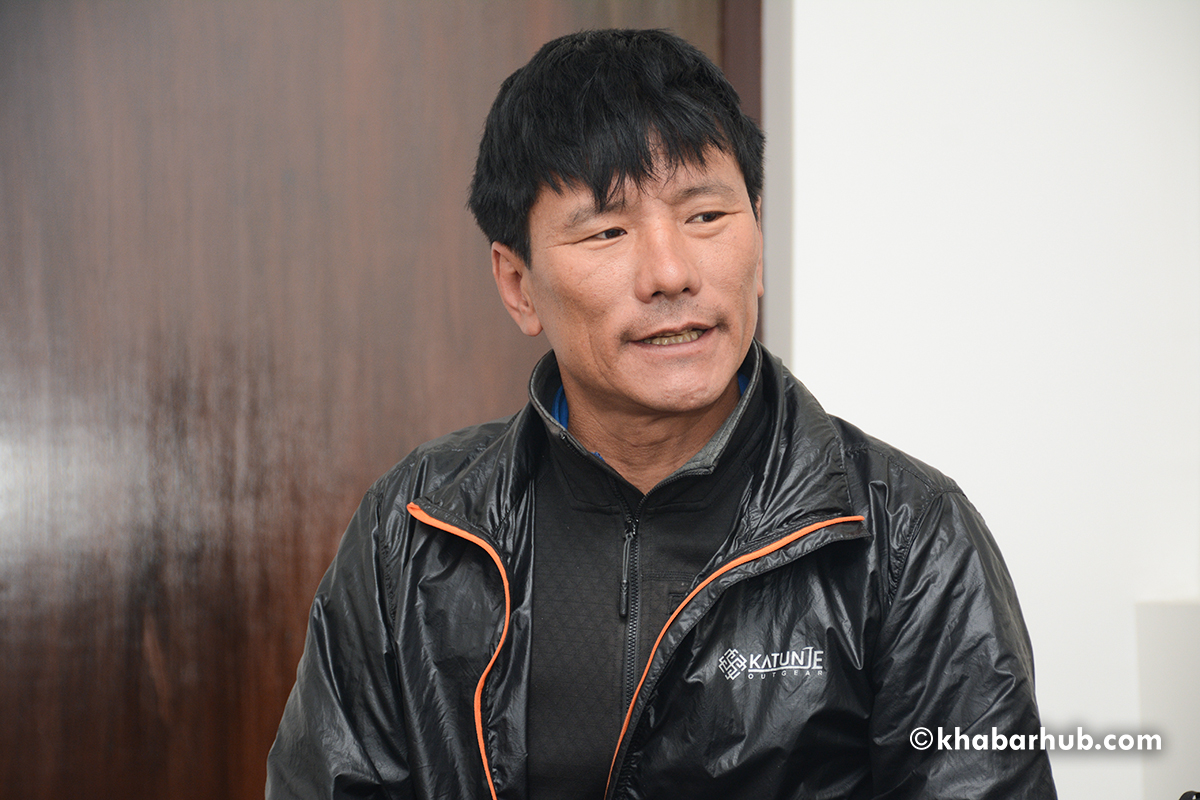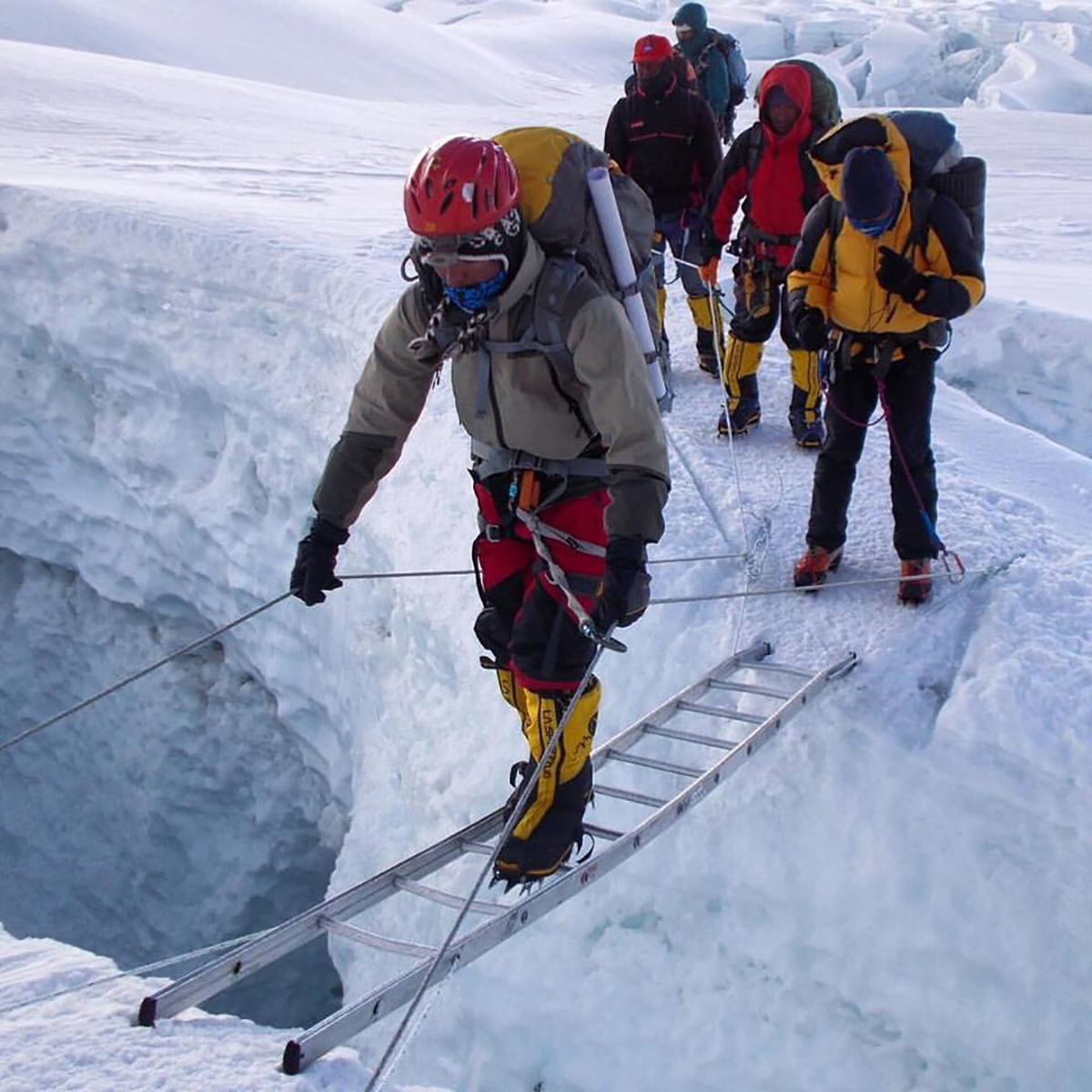0%

KATHMANDU: Sanu Sherpa, 44, now a successful mountaineer with the record of being the third Nepali to climb all 14 peaks above 8,000 meters, is an example of how small dreams can change the destiny of a person.
A little herdsman spending his days gazing the sheep, and yaks in the forest in Sankhuwasabha district, Sanu dreamt of the fanciful and glittering outfits one could enjoy in Kathmandu once one managed to be there and thought, “I cannot fare better unless going to Kathmandu.”
His elders and friends wore glittering dresses. He mesmerized himself: “If I got the chance to go to Kathmandu, I can also wear these sorts of dresses.”
He then left the village in 2005 to find a new job in Kathmandu. He worked as a porter, and a kitchen helper. At the very beginning of 2005, he got a chance to go to Island Peak as a kitchen helper.

“They asked me to deliver the climbing materials,” he said, “I was too strong enough to do this.”
In the year 2006 spring, he got a chance to climb Cho-Oyo with 19 Korean mountaineers with two climbing Sherpas.
“My first attempt finally turned a success after staying some more days in Cho-Oyo,” he shared his first attempt to Cho-Oyo.
“I was desperate that time, as I was in the Camp II, Camp III, for 15 days as helping the mountaineers get down who could not reach the summit due to the health conditions,” Sanu recalled the attempt. “Finally, I succeeded in the summit with two Korean mountaineers. It was my luck that I climbed the first 8,000m mountain in the first attempt,” exulted even at the recount, he shared without taking a breath.
He climbed the Shishapangma from the south face in October the same year.
His continuous efforts prefaced his career began as a mountaineer. From that year, he has continuously scaled the summit of the 8,000 meters every year.
“Though lean and thin in appearance, everybody admired my strength,” he recalls an incident.

“I never believed in records but have faith in my work,” he expounded the journey he had had to make himself the third Nepali to climb 14 peaks. Before him, Mingma Sherpa and his brother, Chhang Dawa Sherpa of Seven Summit Treks had completed this task.
Last year, one day taking a sunbath in his home after returning from climbing the Nanga Parbat, he counted his climbing records. He then found three mountains (Dhaulagiri, Makalu & Gasherbrum II) were still in the bucket of 14 peaks challenging him to conquer. He accepted their call and completed and bagged the 14 peaks bucket this year.
“In the beginning, I never thought of completing the 14 peaks but my persistent efforts made it possible,” Sherpa told Khabarhub.
He has also climbed 7х8000ers twice and hopes to complete the next 7х8000ers within 2 years. If he completed this project, he would be the first Nepali to climb 14 peaks twice.
Likewise, he has proved himself one of the successors of the snow leopard climbing the 10 out of 14 peaks without bottled oxygen.
He told Khabarhub that he used oxygen while climbing Mt Everest, Mt. Makalu, Mt. Kanchanjunga, and Mt. K2.
Comparing the climb experience in different mountains, he said he felt climbing Mt Cho-Oyo the easiest and Mt. Manaslu, Mt. K2 and Shishapangma more challenging. He labeled the latter three as the Technical Mountains requiring special training to climb.

He has a lot to share about his mountain experience, but this ‘Santiago’ unlike in Hemingway’s novel ‘The Old Man and the Sea’, hints at the precaution but enjoys sharing the success story.
“To climb the mountain you need to be equipped with the technical knowledge along with the physical strength.”
“Lack of these elements leads to the failure of 70 percent of the mountaineers and supporting Sherpas.” Sanu explores the causes behind the failed rate.
Like most of the youths sensitized with the climate change issue, he is also aware of global warming and its impact on the mountains.
The decreasing volume of snow in the mountains makes him thoughtful about the fate of the Sherpa’s as the primary victim and the rest of the community living in different parts of the world as the secondary victims.
To him, the excessive heat caused by global warming seems to be ripping the lives of many people dependent on mountains.

“Mountain is my God!” he proclaims rejoicing, “It has given me everything: money, new dresses, a way for living and fame.”
Citing that the government authority is unaware about the problem, he suggests, “If the liaison officers stay at the base camp during the climbing seasons, 90% of the problems will be solved automatically.”
“With the regulating authority’s presence, everything will be controlled, managed and informed.” he added.
He is a bit disappointed with the government for not supporting the Sherpas and demands the government to promote or produce stronger, and more technical youths involved in mountaineering business.
“Otherwise, in 10 years,” he forecasts, “it will be very hard to find Sherpas.”
Sanu Sherpa’s Summit Success:
Dhaulagiri – 2019
Makalu – 2019
Gasherbrum II – 2019
Gasherbrum I – 2013, 2019
Nanga Parbat – 2017, 2018
Everest – 2007, 2008, 2009, 2012, 2013, 2016, 2017
Broad Peak – 2014, 2017
Manaslu – 2010, 2011, 2016
Annapurna – 2016
Kanchenjunga – 2014
K2 – 2012
Lhotse – 2008
Shishapangma – 2006, 2011
Cho Oyu – 2006, 2008